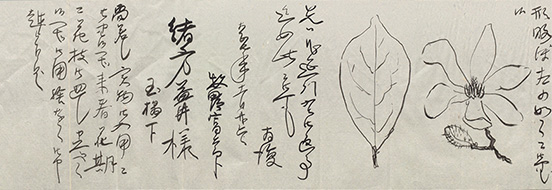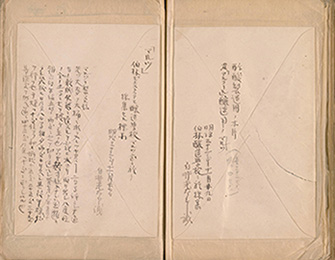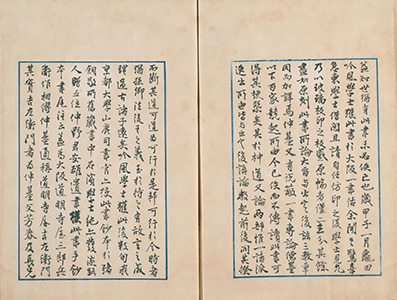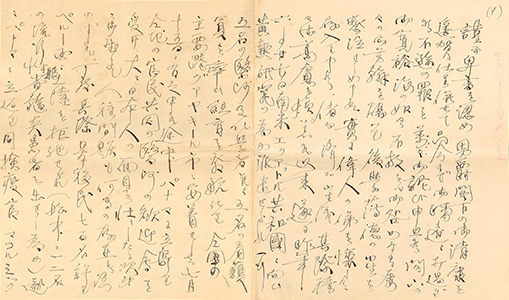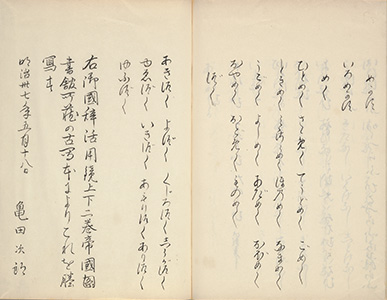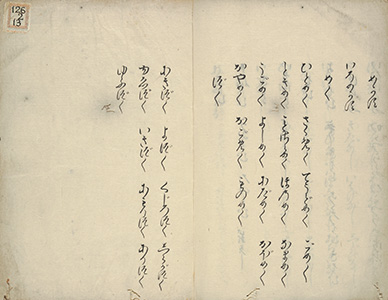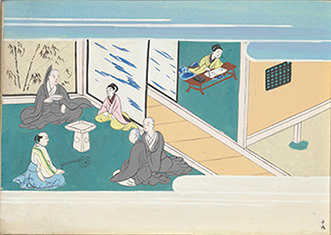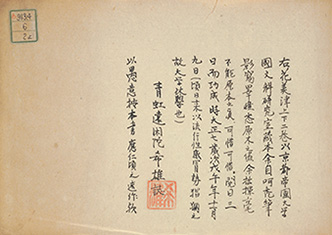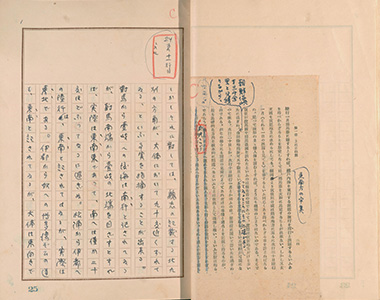Chapter 7 Scholars
MAKINO Tomitaro, 1862-1957
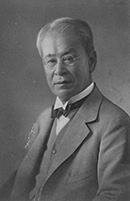 Makino was a botanist. After he dropped out of the elementary school, he studied botany by himself. While he worked as an assistant teacher and instructor at the Science College of the Imperial University of Tokyo (later the Faculty of Science of the University of Tokyo), he named 1,000 new plants and 1,500 varieties. He was called the “father of Japanese botany”.
Makino was a botanist. After he dropped out of the elementary school, he studied botany by himself. While he worked as an assistant teacher and instructor at the Science College of the Imperial University of Tokyo (later the Faculty of Science of the University of Tokyo), he named 1,000 new plants and 1,500 varieties. He was called the “father of Japanese botany”.
76 Makino Tomitaro shokan, November 26, 1918[Watanabe Chiaki Papers: 1122]
This is a letter written by Makino to Ogata Masui who was staying at Count Watanabe Chiaki’s residence. The letter is to answer the questions about the plant, “magnolia kobus”. The flower is drawn on the letter and the postscript says he will send the real flower if necessary when it blooms the following spring. Ogata of the addressee is a person who worked as a curator at the Nara Imperial Museum.
SHIRAI Mitsutaro, 1863-1932
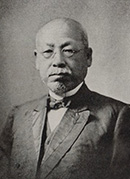 Shirai was a botanist. After he studied in Germany, he taught at the Agriculture College of the Imperial University of Tokyo and played an important role in developing phytopathology. Meanwhile, he published Nihon hakubutsugaku nempyo
Shirai was a botanist. After he studied in Germany, he taught at the Agriculture College of the Imperial University of Tokyo and played an important role in developing phytopathology. Meanwhile, he published Nihon hakubutsugaku nempyo![]() in 1891, in which the process of the development of natural history in Japan was systematically summarized for the first time. He also worked on research and protection of natural monuments. About 6,000 books of Shirai’s old possessions including the ones on the traditional pharmacognosy (study of medicines derived from natural sources) in Japanese, Chinese and Western languages are housed in the National Diet Library as Shirai Collection
in 1891, in which the process of the development of natural history in Japan was systematically summarized for the first time. He also worked on research and protection of natural monuments. About 6,000 books of Shirai’s old possessions including the ones on the traditional pharmacognosy (study of medicines derived from natural sources) in Japanese, Chinese and Western languages are housed in the National Diet Library as Shirai Collection![]() .
.
77 Berurin kimpu, 1899-1901[特1-3645]
Shirai studied in Germany from July, 1899 to October, 1901. This book has his drawings of mushrooms and yeast he researched in Germany. The page shown has the drawing of malts for beer and the beer manufacturing process. Shirai had a great talent in art and he even thought about being a painter. On the previous page (image on the right), a malt sample collected “in the malt room of the Seestraße brewing school in Berlin” kept in the envelope is attached. The Shirai Collection includes his own manuscripts with his diary which are filled with details and lively drawings from which we can feel the power of his spirit.
MINAKATA Kumagusu, 1867-1941
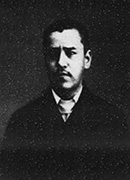 Minakata was an ethnologist and a biologist. He was from Wakayama Prefecture, and was one of the founders of ethnology in Japan. He left the University of Tokyo Prep School, and went to the United States in 1887. He worked in the research department of the East at the British Museum, and studied zoology, botany, archaeology and theology through self-study. He contributed his articles to the Nature and other magazines. After he returned to Japan in 1900, he lived in Tanabe in Wakayama Prefecture, and collected the myxomycete (slime molds) and researched on them. He also studied folklore and closely communicated with the folklorist Yanagita Kunio, and had great influence on the founding period of Japanese folklore.
Minakata was an ethnologist and a biologist. He was from Wakayama Prefecture, and was one of the founders of ethnology in Japan. He left the University of Tokyo Prep School, and went to the United States in 1887. He worked in the research department of the East at the British Museum, and studied zoology, botany, archaeology and theology through self-study. He contributed his articles to the Nature and other magazines. After he returned to Japan in 1900, he lived in Tanabe in Wakayama Prefecture, and collected the myxomycete (slime molds) and researched on them. He also studied folklore and closely communicated with the folklorist Yanagita Kunio, and had great influence on the founding period of Japanese folklore.
78 Shirai Mitsutaro ate shokan, October 24, 1927[W391-N40(31)]
This is a postcard of inquiries on Shirai Mitsutaro’s book written by Minakata. Minakata and Shirai started communicating through the folklorist, Yanagita Kunio, and kept a good relationship all their lives. On the postcard, Minakata is asking Shirai about “Chiyomigusa” written in Shirai’s representative work Nihon hakubutsugaku nempyo![]() (revised version in 1908). He says chiyomigusa is a nickname for chrysanthemum or pine and asks Shirai what this book is about (Chiyomigusa is a book on chrysanthemum). In the postscript, Minakata says he went to the Tokyo Library (one of the predecessors of the National Diet Library) when he was 16 or 17, and read Hakubutsu zassi saying it probably was the first magazine on natural history (this Hakubutsu zassi is still kept in the National Diet Library). “Ono Motoyoshi” who appears in the postcard was a naturalist and a great-great-grandchild of Ono Ranzan.
(revised version in 1908). He says chiyomigusa is a nickname for chrysanthemum or pine and asks Shirai what this book is about (Chiyomigusa is a book on chrysanthemum). In the postscript, Minakata says he went to the Tokyo Library (one of the predecessors of the National Diet Library) when he was 16 or 17, and read Hakubutsu zassi saying it probably was the first magazine on natural history (this Hakubutsu zassi is still kept in the National Diet Library). “Ono Motoyoshi” who appears in the postcard was a naturalist and a great-great-grandchild of Ono Ranzan.
*Image of the cover is of the postcard with a date of October 19, 1926.
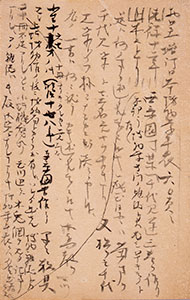

When did postcards come into use?
The kansei hagaki (government-issue postcard) first became available in 1873. Etymologically speaking, the word hagaki was derived from kaeshigaki (refer to the trivia item entitled “Continuing a handwritten letter in the margin at the top”) in the right-hand margin of makigami (refer to the trivia item “Sizes and types of paper”), which was also known as hashigaki (writing at the edge).
In 1900, commercial postcards with a variety of designs were officially authorized and came into common use. A commemorative picture postcard depicting the First Russo-Japanese War (1904–1905) became very popular and provided impetus to a boom in the use of picture postcards.
NAITO Konan, 1866-1934
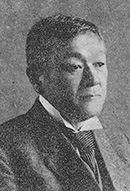 Naito was a scholar of eastern history. He was from Akita Prefecture. After graduating from the Akita Normal School, he went to Tokyo and worked as a journalist. He often went to China and Manchuria for academic research. In 1907, he became an instructor at the Imperial University of Kyoto and later became a professor. He systematized his broad knowledge of eastern history. He is also known as a critic among literary circles during the Meiji era and also known as a calligrapher.
Naito was a scholar of eastern history. He was from Akita Prefecture. After graduating from the Akita Normal School, he went to Tokyo and worked as a journalist. He often went to China and Manchuria for academic research. In 1907, he became an instructor at the Imperial University of Kyoto and later became a professor. He systematized his broad knowledge of eastern history. He is also known as a critic among literary circles during the Meiji era and also known as a calligrapher.
79 TOMINAGA Chuki, Okina no fumi, published by FUJIYA Chobee, 1746[WB1-4]
This is a representative work of Tominaga Chuki, a thinker in the mid-Edo period. It is written for the common people in hiragana and talks about the way of the truth which is more important than Shintoism, Confucianism or Buddhism. It was found be in existence when obtained by Kameda Jiro in 1924. The news of the existence of the book was publicized on the newspaper. The part shown is the afterward Naito wrote to the book Kameda found. In dignified writing, he says he was blown away by the news that the book he was looking for over 30 years was found, and he immediately made the copy using collotype printing equipment. The news of the discovery of the book seems to have been informed through Ishihama Juntaro (the orientalist) who was in the Mongolian Language course at the Osaka Gaikokugo Gakko (Osaka School of Foreign Languages) where Kameda taught Japanese class at that time. There is a letter written by Naito which says, “If I can borrow it, I would like to borrow it as soon as possible.” which shows how excited Naito was (A letter to Ishihama dated January 23, 1924. The National Diet Library keeps the copy made by Kameda.).
NOGUCHI Hideyo, 1876-1928
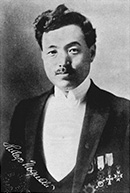 Noguchi was a doctor and a bacteriologist. After being an assistant at the Institute of Infectious Diseases, he worked at the Rockefeller Institute for Medical Research and studied bacteriology. He is known for researching yellow fever and syphilitic. He was nominated for the Nobel Prize in Physiology or Medicine, but Noguchi himself suffered yellow fever while he was studying and died in Accra, Ghana.
Noguchi was a doctor and a bacteriologist. After being an assistant at the Institute of Infectious Diseases, he worked at the Rockefeller Institute for Medical Research and studied bacteriology. He is known for researching yellow fever and syphilitic. He was nominated for the Nobel Prize in Physiology or Medicine, but Noguchi himself suffered yellow fever while he was studying and died in Accra, Ghana.
80 Noguchi Hideyo shokan, April 28, 1919[Ishiguro Tadanori Papers: 936]
This is a letter written by Noguchi Hideyo to Ishihara Tadanori who was an army surgeon and the president of the Japanese Red Cross Society at that time. In the letter, Noguchi says he was sent to Ecuador to research on yellow fever in June, 1918 which is the previous year and he probably had found the bacterium of yellow fever. His research on yellow fever continued until he died in Africa ten years later. Ishiguro who is from Fukushima Prefecture, the same land as Noguchi’s, and made the foundation of the Japanese army surgeon system.
KAMEDA Jiro, 1876-1944
 Kameda was a Japanese Scholar. He was from Hyogo Prefecture. After graduating from the Imperial University of Tokyo, he became a temporary employee of the Committee of Investigation of the Japanese Language, and engaged in research and compilation for establishing standard Japanese. He worked as a professor at the Seventh Higher School (later Kagoshima University), the Osaka Foreign Language School, the Otani University and other schools. He made great achievements in research on old dictionaries and Chinese rhyming dictionaries, researches on Japanese by Westerners. 6,900 books of Kameda Collection including the systematic “setsuyoshu” (popular dictionary) collections from the Muromachi period (14th century) to the Meiji era are housed in the National Diet Library through the mediation of Kindaichi Kyosuke and others. Materials 111 and 115 are from old possessions of Kameda.
Kameda was a Japanese Scholar. He was from Hyogo Prefecture. After graduating from the Imperial University of Tokyo, he became a temporary employee of the Committee of Investigation of the Japanese Language, and engaged in research and compilation for establishing standard Japanese. He worked as a professor at the Seventh Higher School (later Kagoshima University), the Osaka Foreign Language School, the Otani University and other schools. He made great achievements in research on old dictionaries and Chinese rhyming dictionaries, researches on Japanese by Westerners. 6,900 books of Kameda Collection including the systematic “setsuyoshu” (popular dictionary) collections from the Muromachi period (14th century) to the Meiji era are housed in the National Diet Library through the mediation of Kindaichi Kyosuke and others. Materials 111 and 115 are from old possessions of Kameda.
81 MOTOORI Norinaga, Mikuni kotoba katsuyo kagami, 2vol, transcribed by KAMEDA Jiro, 1904[815.4-M8932m2]
These are the copies of the book owned by the Imperial Library (Related material 81) made by Kameda who was 19 years old. The postscript says, “This is a copy of the old manuscript owned by the Imperial Library”. Characters and spaces are exactly the same as in the manuscript, and it could have been copied with the paper being overlaid. It is a curious turn of fate that both the original and the copy are housed in the National Diet Library. The book is about the inflections of the Japanese language.
81 Related material: MOTOORI Norinaga, Mikuni kotoba katsuyo kagami, 2vol, [transcribed in the Edo period][126-13]
Making copies before the invention of the copier
Before the widespread use of printing technology, written materials were often copied by hand. Even after the advent of commercial printing using woodblock technology during the Edo period, materials that were difficult to obtain or not intended for commercial distribution continued to be copied by hand. Scholars, in particular, borrowed and copied rare books repeatedly as part of their studies, and this practice continued even into modern times.
For example, in 1904, Kameda Jiro copied materials by hand in the reading room of the Imperial Library, which was the predecessor of the National Diet Library. Incidentally, copiers first became commercially available during the 1950s.
OKADA Kiyu, 1898-1943
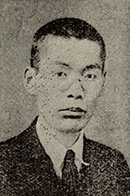 Okada was a scholar of Japanese and Japanese literature. He made remarkable achievements in the history of waka poetry, kanji reading and meaning as well as old dictionaries. He studied at the Imperial University of Kyoto, and became a professor at Ritsumeikan University, but took leave immediately after he became a professor. He died at the age of 46. As he had suffered illness ever since he was young, Okada committed himself to study. His researches and evidences are evaluated as the ones which “strive for authenticity on every last detail” (preface by Shimmura Izuru for the posthumous work Ruiju myogisho no kenkyu). He is also known as a book collector. 1,400 books of his old possessions are housed in the National Diet Library through the Military Academy for Junior Program.
Okada was a scholar of Japanese and Japanese literature. He made remarkable achievements in the history of waka poetry, kanji reading and meaning as well as old dictionaries. He studied at the Imperial University of Kyoto, and became a professor at Ritsumeikan University, but took leave immediately after he became a professor. He died at the age of 46. As he had suffered illness ever since he was young, Okada committed himself to study. His researches and evidences are evaluated as the ones which “strive for authenticity on every last detail” (preface by Shimmura Izuru for the posthumous work Ruiju myogisho no kenkyu). He is also known as a book collector. 1,400 books of his old possessions are housed in the National Diet Library through the Military Academy for Junior Program.
82 Hanamitsu, 2vol, transcribed by OKADA Kiyu, 1918[わ913.4-6]
This is a transcript of nara ehon (old manuscript of fictional stories such as Otogi Zoshi with colored illustration) housed in the Imperial University of Kyoto and copied by Okada who was 21 years old at the time. The postscript says it was copied while the school was temporarily closed due to the Spanish Flu (influenza epidemic resulting in the deaths of tens of millions of people that year and the following year all over the world). It was copied as the original was, but the postscript regrettably says the essence of the book could not have been copied. Hanamitsu is a fictional tragic story of step brothers, Hanamitsu and Tsukimitsu made in the Muromachi period.
WATSUJI Tetsuro, 1889-1960
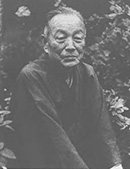 Watsuji was a philosopher and an ethicist. He became a member of the second Shin shicho along with Tanizaki Jun’ichiro and others while he was in the Department of Philosophy at the Imperial University of Tokyo. He studied Friedrich Wilhelm Nietzsche and Søren Aabye Kierkegaard, and also Buddhist art and Japanese history of thought. He frequented the Mokuyo-kai held by Natsume Soseki, and was engaged in compiling the magazine Shiso. He was a professor at the Imperial University of Kyoto in 1931, and was a professor at Imperial University of Tokyo in 1934. Besides Niche kenkyu and Rinrigaku, he made achievements in the study of cultural history such as Koji junrei, Fudo (Climate and culture) and Nihon geijutsushi kenkyu. The National Diet Library has 82 items donated by Mrs. Watsuji Teru including Watsuji’s manuscripts.
Watsuji was a philosopher and an ethicist. He became a member of the second Shin shicho along with Tanizaki Jun’ichiro and others while he was in the Department of Philosophy at the Imperial University of Tokyo. He studied Friedrich Wilhelm Nietzsche and Søren Aabye Kierkegaard, and also Buddhist art and Japanese history of thought. He frequented the Mokuyo-kai held by Natsume Soseki, and was engaged in compiling the magazine Shiso. He was a professor at the Imperial University of Kyoto in 1931, and was a professor at Imperial University of Tokyo in 1934. Besides Niche kenkyu and Rinrigaku, he made achievements in the study of cultural history such as Koji junrei, Fudo (Climate and culture) and Nihon geijutsushi kenkyu. The National Diet Library has 82 items donated by Mrs. Watsuji Teru including Watsuji’s manuscripts.
83 Nihon kodai bunka, Newly-written edition, [1951][WB12-70]
A new manuscript of Nihon kodai bunka which became the last revision. It was first published in 1920, and revised in 1925 and in 1939. The preface of the edited version says, “I had never been so happy as I was when I finished writing this book.” which shows his affection for the book, spending many years on editing it. The inserted material shown has detailed editing directly written on the page of the previous version, and the major edits are written on the manuscript paper with the page to be inserted. Watsuji humbly showed his delight in completing the last revision by saying in the preface, “Inch by inch, I worked on the parts that needed to be clarified and advanced”.




